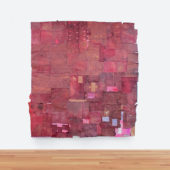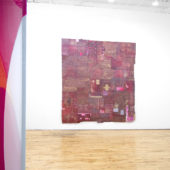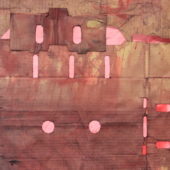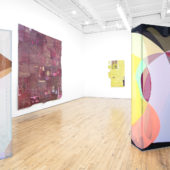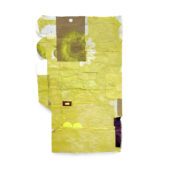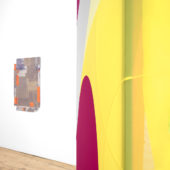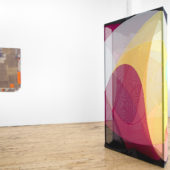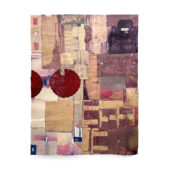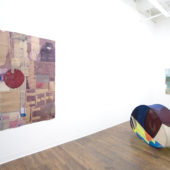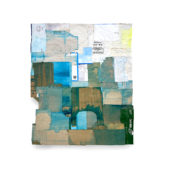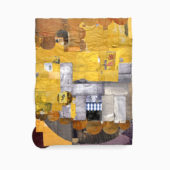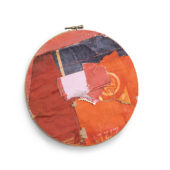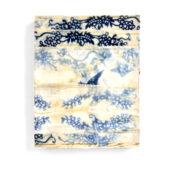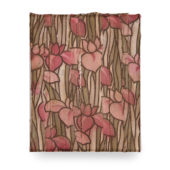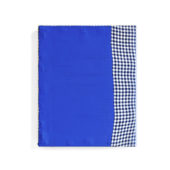One might be tempted to see the recent work of Jodi Hays as endeavoring to aestheticize the abject remainders of our consumer culture. Although the work elevates what we discard to levels far beyond their humble origins, Hays’ collages and paintings advance so many other, more evocative avenues of inquiry. The history of Modernism holds an important place in this artist’s practice as do agricultural geographies and the long history of handmade and handcraft so rooted in the American South. This work is complex and layered—literally. Its strength comes from the skill and intellect of a focused maker. Hays is deeply tied to her personal territories and finds inspiration in how the physical, emotional and psychological domain she inhabits roots her as an artist and thinker.
Considering the complex history of Modernism in painting, Hays’ collage work is intricately woven into a particular formalist trajectory. Broadly speaking, non-objective painting begins with Cezanne, travels through Cubism, moves through the New York School painters and then beyond to artists like Louise Nevelson, Agnes Martin and Sergej Jensen; Hays folds that legacy directly into our current society and culture. Climate change, ecology, over-consumption and material waste are the conceptual frameworks through which Hays reveals, once again, how and why abstract painting can move important ideas forward.
The faceting of form and unfolding of space launched by Cezanne and advanced by Braque and Picasso is reexamined by Hays in the literal unfolding of the volumes of corrugated boxes and cardboard packaging. The flattening of those boxes that transport the stuff of our lives takes on new meaning in these complex paintings. One can see references to Hans Hoffman’s maneuvers addressing the material fact of pigment on canvas to create dynamic spatial events purely through scale, color and shape. Like Hoffman, Hays also playfully teases out fictional and illusionistic space in work that is nothing if not physical celebrations of surface fact.
Louise Nevelson’s gridded and stacked wooden cells are familiar as an organizational strategy found in many of Hays’ compositions. Gravity and weight are strategically balanced through scale and color; hovering over each work, one finds beautiful hierarchies at work. Agnes Martin and Sergej Jensen—coming to formal systems of production from radically different positions—both create meditative experiences by offering the poetic necessity of visuality in painting. Here too, Hays finds alliances in how and why the topographies of her work are so evocative and resonant. Each of these artists—and so many more—have laid the groundwork for Hays to continue taking her discipline into the most rigorous—and risky—arenas.
There is a much lengthier essay to write regarding how rural agricultural landscapes and the traditions of sewing, quilting and repairing are reflected in Hays’ work. These are discussed more fully in past texts about the work, and, for the sake of brevity, will only be touched on here. Those influences are both overt and subtle forces that fuel Hays’ creative engine. The desire to place Hays and her practice within an ever-lengthening historical artery of abstract painting seems the most appropriate and necessary right now. Let’s absorb and revel in the drama and delight that each work offers. Then we can excavate all the compelling references that take us deeper into her practice. Extending any encounter with Hays’ paintings results in great rewards and a wonderfully elevated sense of where and how we are in the world.
Jodi Hays is a painter who exhibits widely across the United States. Her work has been shown at Night Gallery in Los Angeles; Susan Inglett Gallery, New York; Wiregrass Museum, Stoveworks Museum, the Brooks Museum, Tiger Strikes Asteroid (GVL), Fisk University, Curb Center at Vanderbilt University, Cooper Union, Devening Projects, and more.
She is a 2019 Finalist for the Hopper Prize and the recipient of grants from The Foundation for Contemporary Art, Sustainable Arts Foundation,Tennessee Arts Commission, and the Elizabeth Firestone Graham Foundation. Residencies include The Cooper Union School of Art, Oxbow School of Art, and Vermont Studio Center. Her work is documented in catalogues and has been published in New American Painting and Hyperallergic, and positively reviewed in ArtForum International, New Art Examiner, Number Inc. Magazine, the Nashville Scene and Two Coats of Paint.
Her paintings can be found in many public and corporate collections including the Birmingham Museum of Art, The J Crew Group, Nashville International Airport, National Parks of America, Gordon College, the Tennessee State Museum, among others. She lives and works in Nashville, Tennessee.
